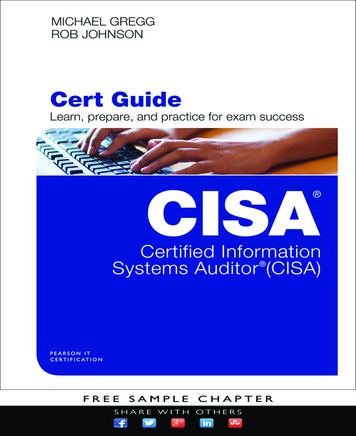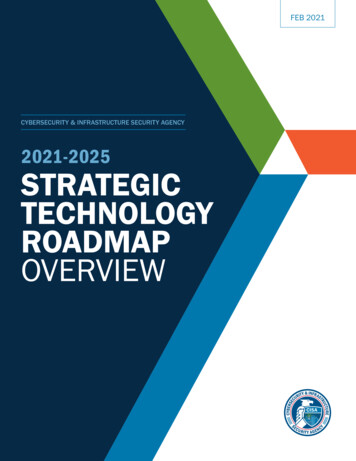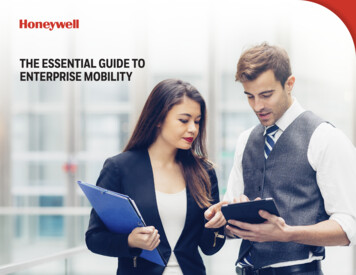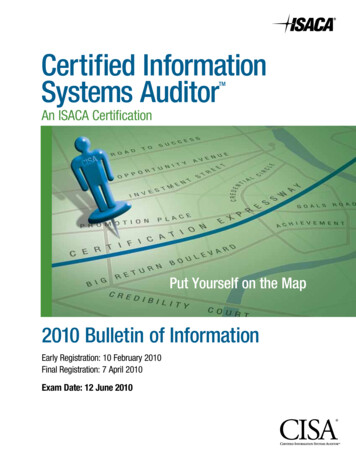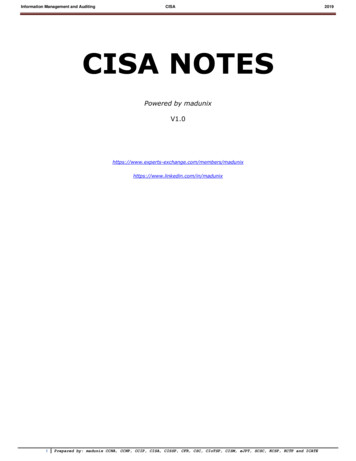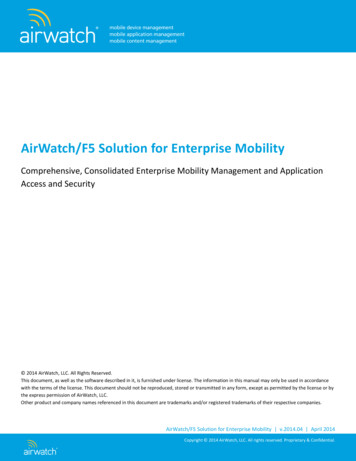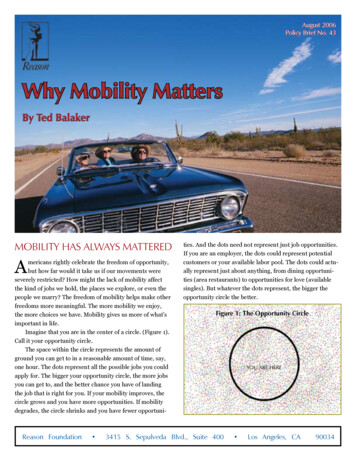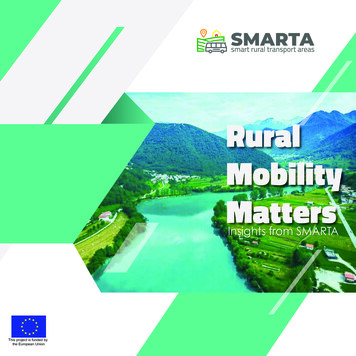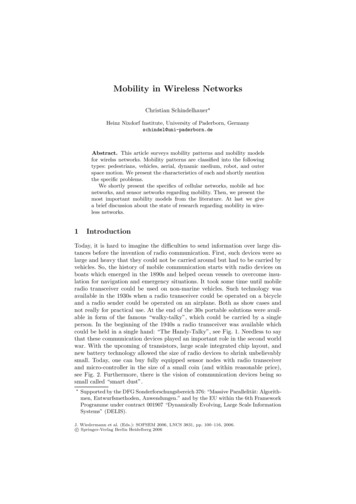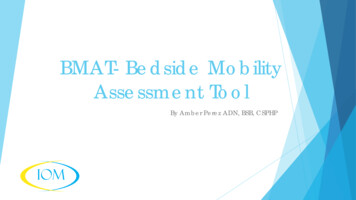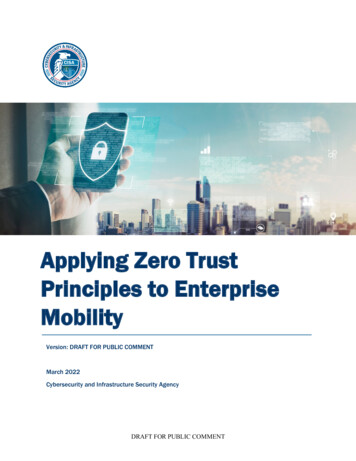
Transcription
Applying Zero TrustPrinciples to EnterpriseMobilityVersion: DRAFT FOR PUBLIC COMMENTMarch 2022Cybersecurity and Infrastructure Security AgencyDRAFT FOR PUBLIC COMMENT
iExecutive SummaryThe concept of zero trust (ZT) has been circulating for a number of years, however recent advanced andpersistent cyberattacks 1 have brought the need for implementing zero trust architectures (ZTA) to theforefront. The May 2021 Executive Order 14028 on Improving the Nation’s Cybersecurity 2 stipulatesgreater impetus for Departments and Agencies to prepare their ZTA plans.Under ZT, access to an information resource (data, applications, and services) is allowed for a specifiedperiod of time with the least possible privileges. Authorization decisions are made through continuousevaluation of the user privileges and the device health as well as other contextual information. Resourcesand infrastructure are monitored actively to assess the current state of security for continuous diagnosticsand mitigation.The mobile security ecosystem has evolved rapidly to keep pace with the pervasiveness of mobile devicesas an enterprise resource used to conduct official business. The mobile security ecosystem includes acollection of enterprise mobile security tools and technologies to protect devices, data, and mobileapplications (apps). Continued security enhancements to mobile operating systems also contribute tomobile device security. Additionally, prominent mobile device manufacturers have integrated tamperresistant hardware components that provide security-critical capabilities such as cryptographic keymanagement. A few vendors are also preparing to respond to the greater security needs of the Federalcommunity by offering continuous, behavior-based identity and access management to better align with ZTprinciples.A mapping between principles from the Cybersecurity and Infrastructure Security Agency (CISA) ZTmaturity model and mobile security tools and technologies highlights the following key takeaways: 12The underpinnings of ZT exist in the mobile security ecosystem. Mobile device operating systemsgenerally include built-in security features for sandboxing, segmentation, and secure memorymanagement.Mobile devices implement application and data segmentation features are consistent with key ZTprinciples.Enterprise Mobility Management (EMM) provides tools to configure and enforce device securitypolicy. Combined with mobile threat defense, these tools can provide a good starting point towardsan agency’s ZT goals for mobile devices.Mobile application development and app security vetting need greater scrutiny to ensure alignmentwith ZT principles for access to enterprise resources (e.g., to support continuous authentication).A tighter integration between EMM and mobile threat defense and enterprise logging, monitoring,diagnostics, and mitigation systems is needed towards meeting ZT requirements of the May 2021Executive Order 14028.U.S. Government Releases Indictment and Several Advisories Detailing Chinese Cyber Threat Activity, July 2021.Executive Office of the President, Executive Order on Improving the Nation’s Cybersecurity, May 2021.DRAFT FOR PUBLIC COMMENT
iiTable of Contents1Introduction . 11.12345Purpose. 1Federal Zero Trust Guidelines . 22.1National Institute of Standards and Technology Zero Trust Architecture . 32.2Department of Defense Zero Trust Reference Architecture . 32.3National Security Agency Zero Trust Reference Architecture . 32.4Executive Office of the President, Executive Order on Improving the Nation’s Cybersecurity . 42.5Cybersecurity and Infrastructure Security Agency Zero Trust Maturity Model, Draft . 52.6OMB’s Zero Trust Strategy . 5Currently Available Security Capabilities for Enterprise Mobility . 73.1Enterprise Mobile Security Technologies . 83.2Operating System Security Capabilities . 93.3Hardware Technologies (HRD) . 93.4Ancillary Capability Enablers (ACE) . 9A Crosswalk Between Zero Trust Principles and Secure Enterprise Mobility . 114.1Cross-Cutting Capabilities . 124.2Governance . 15Conclusion and Proposed Next Steps . 16Acronyms . 17Table of FiguresFigure 1: Interrelationship of Seven Zero Trust Pillars – NSA ZTA . 4Figure 2: CISA Zero Trust Architecture . 5Figure 3: Mobile Security Capabilities Matrix . 11Figure 4: Capabilities Legend . 11Table of TablesTable 1: Enterprise Mobile Security Components . 8Table 2: Mobile Security Capability Mapping . 13Table 3: Mapping to Cross-Cutting Capabilities . 14DRAFT FOR PUBLIC COMMENT
11IntroductionThe concept of zero trust (ZT) goes beyond “trust but verify” to a principle of “never trust, always verify.”ZT is a security model rather than a type of technology. ZT assumes that a breach is inevitable or has alreadyoccurred. Reliance on a ‘moat protecting the castle’ or a single security perimeter is relinquished byremoving the need for implicit trust. Under ZT principles, each resource (application, service, and data) isprotected by its own security capabilities rather than through a shared security infrastructure that protectsthe disappearing network perimeter. This approach limits the lateral spread of breaches. Access decisionsare based on strong authentication and continuous validation. ZT architectures enable the implementationof ZT principles, capabilities, tools, and processes.The use of mobile devices continues to rise. Web access from mobile devices was 54 percent in 2019, andincreased to 61 percent in 2020. 3 Threats directed at mobile devices continue to increase. 4 In the recentpast, some of these threats have resulted in data and password leaks from apps, harvesting of sensitive data,collection of profiles, including tracking of location and other activities, as well as eavesdropping. 5 Further,a growing number of mobile devices are being used to access and/or modify confidential or sensitivecorporate data. Hence, the need for a greater attention to the security of mobile devices, whethergovernment, corporate, or personally owned, has become a necessity.The May 2021 “Executive Order on Improving the Nation’s Cybersecurity” requires agencies to plan andmove toward implementing advanced zero trust architectures for the protection of the FederalGovernment’s information resources, of which federal mobility is an integral part.1.1 PurposeThe Cybersecurity and Infrastructure Security Agency (CISA) is providing this material to Federal agenciesas they evolve and operationalize cybersecurity programs and capabilities, including cybersecurity formobility. Material presented in this document is intended to inform agencies about how zero trust principlescan be applied to currently available mobile security technologies that are likely already part of a federalenterprise’s mobility program.Towards this goal, available Federal ZT architectural frameworks are discussed. These frameworks offer astructured set of ZT principles and capabilities to achieve a target state desired by an agency. The availablemobile security approaches are then mapped into the ZT principles to help Federal agencies developstrategies to align a program’s mobile security capabilities towards its ZT goals.While the ZT architectural principles and the available mobile security technologies/techniques are outlinedin this document, these are high-level and are offered to convey how these available mobile security toolscan be applied towards organizational ZT goals. Hence the material presented is not intended to be animplementation guide for either ZT or Enterprise Mobility.Google/Perficient, Mobile vs. Desktop Usage in 2020, March 2021.NIST NCCOE, Mobile Threat Catalogue, 2019.5 NowSecure, Mobile App Security in a Zero Trust Environment, March 2021.34DRAFT FOR PUBLIC COMMENT
22Federal Zero Trust GuidelinesIn order to distill ZT principles and capabilities applicable to enterprise mobility, this section provides anoverview of the following federal ZT guidelines and documents:a.b.c.d.National Institute of Standards and Technology Zero Trust Architecture, August 2020 6Department of Defense Zero Trust Reference Architecture, February 20217National Security Agency (NSA) Zero Trust Reference Architecture, May 2021 8Executive Office of the President, Executive Order 14028, “Improving the Nation’sCybersecurity,” May 2021 9e. Cybersecurity and Infrastructure Security Agency’s (CISA) Zero Trust Maturity Model, Draft, June2021 10f. OMB’s Draft Zero Trust Strategy: Moving the U.S. Government Towards Zero Trust CybersecurityPrinciples, September 2021 11These guidelines cover a broad perspective of Zero Trust approaches. Some are more formal than others,yet contain basic tenets of ZT.NIST’s ZT document, which was released the earliest, starts with a list of ZT tenets and an introduction toZero Trust Architecture (ZTA) through an interrelationship of logical components; leading up to applyingaspects of a ZTA to enterprise use-cases to provide greater security and protection against exploitations.The Department of Defense’s ZTA document presents a structured architecture using Department ofDefense Architecture Framework (DoDAF) views and an introduction to the seven pillars of ZTA. NSA’sZTA is very similar to DoD’s ZTA and includes the same seven Pillars. These two ZTAs differ in theirfocus – DoD’s ZTA is for itself while the NSA ZTA is for the NSA and Defense Industrial Baseorganizations.The Executive Order (EO) on Improving the Nation’s Cybersecurity (hereafter Cybersecurity EO) calls forDepartments and Agencies to plan, advance, and move towards adopting ZTA.CISA released its ZT Maturity Model in response to the Cybersecurity EO to aid Federal Civilian ExecutiveBranch (FCEB) agencies through their journey towards a desired ZTA state. CISA’s document uses fivedistinct pillars supported by overarching capabilities for Visibility/Analytics, Automation/Orchestration,and Governance.The Office of Management and Budget (OMB) issued a ZT strategy document in response to theCybersecurity EO that requires Federal agencies to achieve certain specific ZT goals by the end of FiscalYear (FY) 2024.A review of the above guidelines reveals that the mobile device is treated as another end-point device.This document highlights a need for special consideration for mobile devices and associated enterprisesecurity management capabilities due to their technological evolution and ubiquitous use.NIST, Zero Trust Architecture - SP 800-207, August 2020.Department of Defense, DoD Zero Trust Architecture v1.0, February 2021.8 NSA, DRAFT National Security Systems Zero Trust Reference Architecture (NSS ZT RA), MAY 2021.9 Ibid., i10 CISA, Zero Trust Maturity Model, June 2021.11 OMB, Moving the U.S. Government Towards Zero Trust Cybersecurity Principles, September 2021.67DRAFT FOR PUBLIC COMMENT
32.1 National Institute of Standards and Technology Zero Trust ArchitectureNational Institute of Standards and Technology’s (NIST) Special Publication (SP) 800-207 of August 2020defines zero trust:Zero trust (ZT) provides a collection of concepts and ideas designed to minimize uncertaintyin enforcing accurate, least privilege per-request access decisions in information systemsand services in the face of a network viewed as compromised. Zero trust architecture (ZTA)is an enterprise’s cybersecurity plan that utilizes zero trust concepts and encompassescomponent relationships, workflow planning, and access policies. Therefore, a zero trustenterprise is the network infrastructure (physical and virtual) and operational policies thatare in place for an enterprise as a product of a zero trust architecture plan.NIST SP 800-207 outlines how ZT tenets can be applied to build a ZT architecture and then offers a broadset of use cases where ZT can be applied. It also profiles possible threats to an enterprise within the contextof ZTA oriented mitigations and discusses how the ZT tenets can be applied to existing Federal complianceguidance. The final section of the document offers suggestions on migrating to ZT architecture forapplications and infrastructure.2.2 Department of Defense Zero Trust Reference ArchitectureThe Department of Defense’s (DoD) Zero Trust Reference Architecture of February 2021 categorizes ZTprinciples and technologies into seven ‘pillars’: User, Device, Network/Environment, Application andWorkload, Data, Visibility and Analytics, and Automation and Orchestration.From an architectural standpoint, end-state DoD ZTA pillars are outlined below:1. User: Identifying users and enabling trusted access to organizational information resources is oneof the key characteristics of a ZTA.2. Device: Assurance that a vetted device is used to access applications and data is essential in ZT.3. Network/Environment: This pillar pertains to the level of granularity of isolation of theinformation resources by means of network segmentation and control (on or off-premises) forenforcing access and policy restrictions.4. Applications and Workload: This category includes tasks or services offered from systemsresiding on-premises or in the cloud.5. Data: For a comprehensive ZT approach, integrated protection of data, applications, assets, andservices is essential. Techniques like Digital Rights Management (DRM), Data Loss Prevention(DLP), software defined storage, and data tagging are effective in protecting the data.6. Visibility and Analytics: Observance of performance and behavior, along with sensor andtelemetry data, and an activity baseline are essential to the detection of anomalous activity,permitting adaptations to security policy and real-time access control.7. Automation and Orchestration: For holistic and timely assessment of threats, manual securityprocesses are automated to derive actionable information from disparate security tools (SecurityOrchestration, Automation and Response [SOAR]) across an organization, enabling automatedresponse.2.3 National Security Agency Zero Trust Reference ArchitectureThe draft National Security Agency (NSA) Zero Trust Reference Architecture (RA) of May 2021 is verysimilar to the DoD ZT RA. NSA developed its RA as a reference for non-DoD stakeholders who cannotleverage the capabilities described in the DoD zero trust RA. The focus of DoD’s RA is DoD and its missionDRAFT FOR PUBLIC COMMENT
4partners, while the NSA RA covers itself, National Security Systems, and the Defense Industrial Base. NSAdefines ZT as:Zero Trust is a cybersecurity strategy that embeds security throughout the architecture for thepurpose of stopping or mitigating data breaches and reducing cybersecurity operational risk.This data-centric security model eliminates the idea of trusted or untrusted networks, devices,personas, or processes and shifts to multi-attribute-based confidence levels that enableauthentication and authorization policies under the concept of least privileged access.In this reference architecture, the fundamental drivers are i) Never Trust, Always Verify, ii) Assume Breach,and iii) Verify Explicitly.As with DoD’s RA, this framework is divided into seven pillars: Users, Devices, Network/Environment,Applications/Workloads, Data, Visibility and Analytics, and Automation and Orchestration. Theseconcepts are interrelated as depicted in Figure 1 below:Figure 1: Interrelationship of Seven Zero Trust Pillars – NSA ZTA2.4 Executive Office of the President, Executive Order on Improving theNation’s CybersecurityThis Cybersecurity EO calls on the FCEB agencies to develop plans towards adopting Zero TrustArchitecture and secure cloud services. The Cybersecurity EO defines ZT as “a security model, aset of system design principles, and a coordinated cybersecurity and system managementstrategy based on an acknowledgement that threats exist both inside and outside traditionalnetwork boundaries.” It describes how the ZT security model eliminates implicit trust andrequires continuous verification of the operational picture based on real-time information frommultiple sources to allow minimal access to resources, while looking for anomalous or maliciousactivity. The EO also highlights the need for “comprehensive security monitoring; granular riskbased access controls; and system security automation in a coordinated manner throughout allaspects of the infrastructure in order to focus on protecting data in real-time within a dynamicthreat environment.”DRAFT FOR PUBLIC COMMENT
52.5 Cybersecurity and Infrastructure Security Agency Zero Trust MaturityModel, DraftCISA’s draft Zero Trust Maturity Model of June 2021 draws upon the pillars concept from the DoD andNSA ZTAs. This document is designed to inform FCEB agencies as they develop their ZT implementationplans in response to Executive Order 14028. CISA’s pillars align to the first five pillars of the DoD/NSAarchitectures with the first one renamed Identity rather than User. Visibility and Analytics and Automationand Orchestration capabilities are layered across the five pillars with a Governance layer holding the wholestructure from the bottom (Figure 2).Figure 2: CISA Zero Trust ArchitectureAt a high-level, the pillars in this model are described as follows:1. An Identity refers to an attribute or set of attributes that uniquely describe an agency user or entity.2. A Device refers to any hardware asset that can connect to a network, including internet of things(IoT) devices, mobile phones, laptops, servers, and others.3. A Network refers to an open communications medium, including agency internal networks,wireless networks, and the Internet, used to transport messages.4. Applications and workloads include agency systems, computer programs, and services thatexecute on-premises, as well as in a cloud environment.5. Data refers to any information an agency needs to conduct its business, whether on-premises orresiding in an off-premises cloud.2.6 OMB’s Zero Trust StrategyOMB issued this document in response to the Cybersecurity EO to bring all Federal agencies to a commonroadmap toward their journey to a “highly mature zero trust architecture”.This strategy strives to facilitate government-wide shared services for Federal agencies in achieving theirZT goals. In this document the Cybersecurity EO’s requirements for Federal agencies are detailed in termsof CISA’s five pillars of ZT. Visibility and analytics as well as SOAR are called for within the Data pillar.In summary, this strategy document identifies a ZTA with the following principles: “Bolsters strong identity practices across Federal agencies;DRAFT FOR PUBLIC COMMENT
6 Relies on encryption and application testing instead of perimeter security;Recognizes every device and resource the Government has;Supports intelligent automation of security actions; andEnables safe and robust use of cloud services.”DRAFT FOR PUBLIC COMMENT
73Currently Available Security Capabilities for EnterpriseMobilityThis section outlines currently available and generally practiced security capabilities for enterprise mobility.The information presented below is largely drawn from the following: NIST SP 800-124, Guidelines for Managing the Security of Mobile Devices in the Enterprise,Revision 2 (Draft). 12 Department of Homeland Security Study on Mobile Device Security. 13 NIST Mobile Threat Catalogue. 14 An Overview of the Mobile Security Ecosystem (Draft), Advanced Technology Academic ResearchCenter (ATARC)/FISMA Mobility Metrics Working Group (FMMWG). 15 International Travel Guidance for Government Mobile Devices (Draft). 16 .gov Cybersecurity Architecture Review (govCAR) Recommendations: Mobile Cybersecurity (Spin 5). 17 Other sources, including various industry publications and vendor materials.In the next section (Section 4), these security capabilities will be mapped onto the ZT principles/tenets andcapabilities presented in Section 2 to inform agencies and aid in the identification of gaps for whichstrategies would need to be developed to attain organizational ZT goals for enterprise mobility.Table 1 lists components of the mobile security ecosystem, largely drawn from NIST SP 800-124, whichagencies must assess to ascertain their applicability to the agency’s mobile security program. The NIST SP800-124 offers detailed explanations of all these categories, with the exception of the “Ancillary CapabilityEnablers” described below. These capabilities are categorized into three major sections: Enterprise Mobile Security Technologies, including EMM, Operating System (OS) security capabilities, and Other capabilities, including specialized hardware components and ancillary capability enablers.NIST, Guidelines for Managing the Security of Mobile Devices in the Enterprise – SP 800-124r2 Draft, March 2020.13 DHSS&T, Study on Mobile Device Security, April 2017.13 DHS S&T, Study on Mobile Device Security, April 2017.14 NIST, Mobile Threat Catalogue, https://pages.nist.gov/mobile-threat-catalogue/15 An Overview of the Mobility Security Ecosystem (Draft), August 2021.16 International Travel Guidance for Government Mobile Devices (Draft), August 2021.17 DHS CISA, .govCAR Recommendations: Mobile Cybersecurity, August 2018.12DRAFT FOR PUBLIC COMMENT
8Table 1: Enterprise Mobile Security Components3.1 Enterprise Mobile Security TechnologiesEnterprise Mobile Security Technologies are used to securely deploy mobile devices with appropriateorganizational policies and secure configurations that are relevant to applicable use cases. Devices areautomatically monitored for policy violations and for mitigation actions while reporting on allowedactivities (e.g., sites visited). Primary Enterprise Mobile Security Technologies, as described in NIST SP800-124, are outlined below: Enterprise Mobility Management (EMM): An EMM enforces organizational security policiesfor the management of mobile devices through configuration and functionality control. EMMcapabilities include: Mobile Device Management (MDM): The MDM functionality of an EMM ecosystemleverages the platform management Application Programming Interfaces (APIs) offered by amobile OS to manage the mobile device. These APIs enable access to management of deviceconfiguration and security settings. Access to these APIs is restricted to a select set ofdevelopers vetted by platform owners. Policy Enforcement (PET): The policy enforcement component of EMMs includes themanagement of user and application access to device sensors; management of the device; andadministration of wireless network interfaces (e.g., WiFi, Bluetooth, Near FieldCommunication); detects changes to the security baseline; and limits access to enterpriseresources depending on device model, OS version, etc. User and Device Authentication (UDA): Identity and access management is central toapplying zero trust principles to achieve a required level of assurance in protectingorganizational information resources from unauthorized or malicious actors. TraditionalEMMs have provided capable identity and access control services for mobile devices and users.DRAFT FOR PUBLIC COMMENT
9 However, one of the key tenets of ZT is continuous authentication, where user and deviceaccess assessments are required for every access request and persistence of authorizationcannot be relied upon. Communications and Storage Controls (CSC): EMM capabilities are also used to securemobile device communications and storage for increased protection of the information on thedevice or access through the device.Mobile App Vetting (MAV): MAV security testing processes and solutions are used to ensureapps do not contain exploitable known vulnerabilities and comply with applicable enterprisepolicies before they are deployed onto enterprise mobile devices.Mobile Application Management (MAM): MAM systems are used to manage apps installed onorganizational devices and to ensure policy compliance.Mobile Threat Defense (MTD): MTD solutions protect devices by detecting and mitigatingthreats posed by risky user behavior, suspicious network activity, or malicious attacks and usecounter measures for defense.Secure Containers (SCT): These isolation techniques are used to prevent leakage of informationbetween organizational and personal data.3.2 Operating System Security CapabilitiesMobile OSes come with a plethora of built-in security features. Some are enabled by default and others areactivated through configuration management controls as directed by an enterprise policy. The followingbroad security technologies are common to major mobile OSes. Data Isolation Techniques (DIT): DIT techniques are used to block unauthorized communicationamong device and user data stores.Platform Management APIs (PMA): Platform management APIs and related protocols areoffered by OS vendors that allow EMMs and other security management tools to control devicesecurity and functionality. Such OS features are only exposed to select partners and devicemanufacturers.Virtual Private Network (VPN): VPNs are used to maintain confidentiality of information whilein transit. VPN granularity levels are maintained by mobile OSes with built-in support for networklevel VPNs and also support for app-level VPNs as well as session (Web-Transport Layer Security[TLS]) level VPNs. These VPNs can be invoked through APIs.Authentication (ATH): User and device identification is a key enabler towards compliance withzero trust architectures. Identity credentials are accessed through MFA including certificate-basedand/or biometric means for authentication mechanisms offered on mobile devices.3.3 Hardware Technologies (HRD)Several mobile device manufacturers are building in dedicated hardware components to strengthen securityof information. Some devices are equipped with dedicated and self-contained System-on-a-Chip (SoC) orTrusted Execution Environment (TEE) technology to physically isolate all the resources needed forprocessing of sensitive information. In some cases Trusted Platform Module (TPM), a dedicatedmicrocontroller, is used to perform cryptographic operations and manage cryptographic keys.3.4 Ancillary Capability Enablers (ACE)This section provides a breakdown of emerging commercial activities leading to a combination of servicesand solutions that are somewhat outside the realm of traditional EMMs.DRAFT FOR PUBLIC COMMENT
10The information summarized in this section is gleaned from relevant external service providers and mobilesecurity vendors’ websites. In addition, a few mobile security vendors were invited to provide additionalclarification of information on their ZT capabilities and plans.A number of external service providers offer services to facilitate identity and access management. Theseservices are based on standards and include single-sign-on (SSO) with strong multi-factor authentication.These identity services integrate with commonly available directory services in the cloud, enabling secureaccess to organizational resources.Based on the gathered information, it appears that most vendors are attempting to align their UnifiedEndpoint Management (UEM) offerings to a ZTA. Some vendors are beginning to offer solutions thatimplement continuous authentication assessment, both crucial ZT requirements, and device healthreporting. These offerings complement MTD capabilities and integrate with leading MDMs to effect timelythreat mitigations. At least two commercial solutions offer ‘intelligent’ device authentication, wherebiometrics are combined with usage behavior that would be unique to a given user. Some offerings haveclaimed multi-factor based per app authentication support.DRAFT FOR PUBLIC COMMENT
114A Crosswalk Between Zero Trust Principles and SecureEnterprise MobilityIn this section, an approach is presented to aid in the development of a ZT mindset for enterprise mobility.A mapping is offered between the target ZT principles and the corre
OMB's Draft Zero Trust Strategy: Moving the U.S. Government Towards Zero Trust Cybersecurity Principles, September 2021 . Zero trust architecture (ZTA) is an enterprise's cybersecurity plan that utilizes zero trust concepts and encompasses component relationships, workflow planning, and access policies. Therefore, a zero trust
